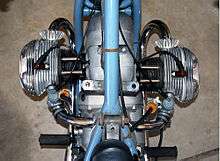Multi-cylinder engine
For multiple-cylinder steam engines, see Compound steam engine and Triple-expansion steam engine
.jpg)

A multi-cylinder engine is a reciprocating internal combustion engine with multiple cylinders. It can be either a 2-stroke or 4-stroke engine, and can be either Diesel or spark-ignition. The cylinders and the crankshaft which is driven by and co-ordinates the motion of the pistons can be configured in a wide variety of ways. Multi-cylinder engines offer a number of advantages over single-cylinder engines, chiefly with their ability to neutralize imbalances by having corresponding mechanisms moving in opposing directions during the operation of the engine.[1] A multiple-cylinder engine is also capable of delivering higher revolutions per minute (RPM) than a single-cylinder engine of equal displacement, because the stroke of the pistons is reduced, decreasing the distance necessary for a piston to travel back and forth per each rotation of the crankshaft, and thus limiting the piston speed for a given RPM. Typically, the more cylinders an engine has, the higher the RPM's it can attain for a given displacement and technology level, at a cost of increased friction losses and complexity. Peak torque is also reduced, but the total horsepower is increased due to the higher RPM's attained.
Although there are 1, 3 and 5-cylinder engines, almost all other inline engines are built with even numbers of cylinders, as it's easier to balance out the mechanical vibrations. Another form of multiple-cylinder internal combustion engine is the radial engine, with cylinders arranged in a star pattern around a central crankshaft. Radial engines are most commonly used as aircraft engines, and in basic single-row configuration are typically built with odd numbers of cylinders (from 3 to 9), as odd numbers are easier to balance in this configuration. "Twin-row" or "multi-row" radials are also built, which is basically two or more single-row radials connected front-to-back and driving a common crankshaft. In this "twin row", or "multi-row" configuration, the total number of cylinders will be an even number, although each row still has an odd number. For example, a typical single row radial such as the Wright Cyclone has 9 cylinders. The twin row Wright Twin Cyclone is based on this engine and thus has two banks of 9 cylinders, for a total of 18, an even number.
Common configurations
Two-cylinder engines
Configurations of two-cylinder engines include:
- Straight-twin engine, or "parallel twin" with two cylinders in parallel sharing a crankshaft.
- V-twin engine, or "V2" engine, two cylinders in V configuration, sharing a crankshaft.
- Flat-twin engine, a flat engine with 2 opposed cylinders on the same crankshaft angled 180° to each other.
Three-cylinder engines
Configurations of three-cylinder engines include:
- Straight-three engine, also called the inline-triple, inline-3, or I-3 engine, the most common three-cylinder internal combustion engine.
- V3 engine, seen on some two-stroke racing motorcycles.
- W engine with three cylinders (W3), such as the Anzani 3-cylinder fan engines, ("W"and radial three-cylinder engines of 1905 to 1915, used in the Blériot XI which first flew the English Channel among other applications).
Four-cylinder engines
Configurations of four-cylinder engines include: the most common 4-cylinder engine
- Inline-four engine, an engine with 4 cylinders in a straight line.
- V4 engine, an engine with 4 cylinders arranged in a V configuration.
- Flat-four engine, a flat engine with 4 cylinders horizontally opposed to each other at 180° apart.
- Square four engine (U4 engine), two banks of 2 cylinders, each driving a single crankshaft and geared to a common output shaft.
Five-cylinder engines
Configurations of five-cylinder engines include:
- Straight-five engine, an engine with 5 cylinders in a straight line.
- VR5 engine, an engine with 5 cylinders staggered slightly, allowing cylinder bore centerlines to be closer together, reducing overall engine length.
Six-cylinder engines
Configurations of six-cylinder engines include:
- V6 engine, a V engine with six cylinders.
- VR6 engine, a compromise between a V6 and straight-6 engine, shorter than a straight-6 and narrower than a V-6.
- Straight-six engine, an engine with six cylinders aligned in a straight line.
- Flat-six engine, a flat engine with two banks of 3 cylinders horizontally opposed at 180° apart.
Eight-cylinder engines
Configurations of eight-cylinder engines include:
- V8 engine, an engine with 8 cylinders arranged in a V configuration.
- Straight-eight engine, an engine with 8 cylinders in a straight line.
- Flat-eight engine, a flat engine with 8 cylinders horizontally opposed to each other at 180° apart.
- W8 engine, an engine with 8 cylinders in four banks of 2, arranged in a "W" configuration.
Ten-cylinder engines
Configurations of ten-cylinder engines include:
- V10 engine, a V-engine with ten cylinders.
- Straight-10 engine, an engine with ten cylinders aligned in a single row.
Twelve-cylinder engines
Configurations of twelve-cylinder engines include:
- Straight-12 engine, a straight engine with twelve cylinders.
- V12 engine, a V engine with twelve cylinders.
- Flat-twelve engine, a flat engine with twelve cylinders.
- W12 engine, a W engine with twelve cylinders in either four groups of 3, or three groups of 4.
Larger configurations
References
- ↑ Victor Albert Walter Hillier, Peter Coombes, Hillier's Fundamentals of Motor Vehicle Technology, Book 1 (2004), p. 47.
